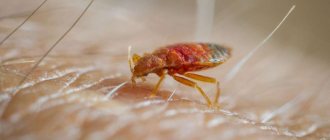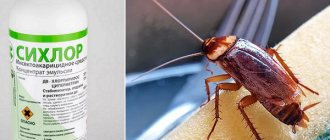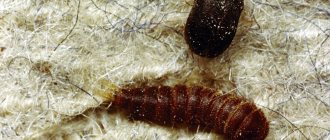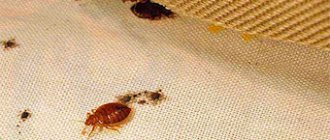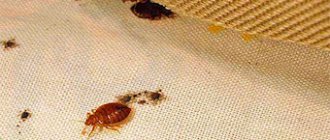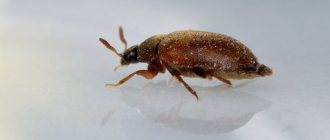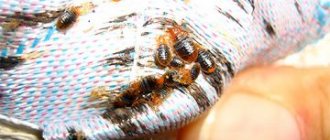30.04.2021
Dormitories suffer from bed bug infestations more than apartment buildings. These blood-sucking parasites appear even in those hostels where order is maintained, where the sanitary and hygienic conditions are considered satisfactory or good. To ensure that a large number of people can live in comparative comfort in rather cramped conditions, you need to know how to get rid of bedbugs in a hostel and how to prevent their appearance and spread.
Why do bedbugs appear in dormitories?
There are several reasons for the frequent and massive appearance of bedbugs in dormitories:
- This is a temporary place of residence, people do not consider this home theirs, so they do not monitor its cleanliness, and do not consider it necessary to fight pests.
- People come to the hostel from different places, sometimes moving from one to another. Bring bedbugs or their eggs with you and your personal belongings.
- Living in a dormitory is more crowded than living in apartments. Several people live in one room; there is little space, a lot of furniture and personal belongings. These are ideal conditions for bedbugs to breed.
- The rooms in such buildings are located nearby. Often this is a corridor type, when all rooms open onto a single long corridor, and the kitchen and showers are common areas, they are located separately. This is inconvenient and does not allow you to maintain hygiene. And close proximity only makes it easier for bedbugs to spread throughout the territory: they easily move through sockets, cracks in walls, ventilation, or simply through doors from one room to another.
In a word, in any student or work dormitories, as well as in hostels or hotels in the budget segment, there are excellent conditions for bedbugs.
How to recognize a bedbug nest
Nests are places of accumulation and main activity of parasites, which have obvious characteristic signs:
- accumulation of black dots (excrement) in one area;
- presence of eggs;
- dry skins of larvae;
- a cluster of insects of different ages and sizes.
To create nests, bedbugs find secluded places where it would be comfortable for them to develop and reproduce. The more cluttered the room, the greater the likelihood of bedbugs appearing there. The most common places where parasites accumulate can be:
- under the joints of wallpaper that has peeled off;
- the top of the curtains;
- for paintings and wall hangings;
- books and bookshelves;
- pet or bird cages;
- cracks in parquet or under baseboards;
- under and inside furniture;
- in sockets and switches;
- under the windowsill;
- in window frames;
- electrical appliances;
- near the batteries.
Features of the fight against bedbugs in a hostel
You won’t be able to get rid of bedbugs in one living space on your own. The pests will come again from the neighbors. It is impossible to ensure that all residents simultaneously poison pests on their own. If we can come to an agreement, then there are probably unoccupied rooms in the dorm where bedbugs can temporarily hide. In case of danger, they can be without food for some time, so they will hide where there is no poison. That is, after disinfestation they will return.
It’s good if the hostel has shift changes between workers moving in, vacations for students, and other periods of time when people don’t live there. At this time, management should order a complete disinfestation of the building and the furniture in it. This way the bedbugs are guaranteed to die.
Allergies and depression
Everyone knows that bedbug bites often cause allergic reactions on the skin (redness, itching) - few know that insects can also stimulate depressive conditions.
Pavel Alexandrov: “Nowadays, bed bugs practically do not carry infectious diseases. Previously, during wars, the transmission of typhus could not be ruled out, but recently nothing has been heard about this.
However, bedbugs are a common cause of allergic diseases. Itchy rashes on the body that appear after bedbug bites can last a long time.
Theoretically, a bug can transmit hepatitis B if it sucks the blood of a sick person, then crawls onto a healthy person, bites him, and then the person crushes the bug. But you see for yourself, the algorithm is complex, there are no confirmed cases in science.
Although the body of bedbugs can contain pathogens of a number of diseases, it is still considered probable that they only transmit the hepatitis B virus
A bedbug can definitely be one of the reasons for a bad mood in young children: bedbug bites are quite painful, children are sensitive to it - they begin to have an allergic reaction, constant itching prevents them from sleeping, children become irritable and whiny. As for adults, constant itching and, as a result, poor sleep can cause depression.
In addition, bedbugs can be mechanical carriers of intestinal infections, but this is the case if a person sleeps and eats in the same place. They crawl over food, collect dirt behind baseboards - and carry it all on their paws. But this happens rarely, since most often bedbugs live under mattresses, behind pictures, under the carpet, and not next to food.”
Dmitry Gapon: “A certain harm from bed bugs is the disruption of a person’s normal sleep; their bites can cause redness of the skin, the formation of a rash, itching, an allergic reaction, and in rare cases, anaphylactic shock. There is no reliable information about the transmission of pathogens of infectious and invasive diseases by bed bugs. Although the causative agents of a number of such diseases can be in the body of bedbugs, it is still considered only probable that they transmit the hepatitis B virus.”
Why you need to get rid of bedbugs in a hostel
The fight against bed bugs should begin as soon as the insects are found in the room. If this is not done, in a few months bedbugs will breed on all floors of the building. If you don't get rid of insects, they will make life unbearable. Bedbug bites can be painful and unpleasant; a person scratches them, and through scratching and scratching an infection can be introduced into the blood. Bedbugs are carriers of infectious and viral diseases. Considering that the hostel has a very high population density, one insect can bite and drink the blood of several people in its life, transferring diseases from one to another.
New old problem
In the 1990s, residents of big cities conveniently forgot about the problem of bed bugs. In the 21st century, say both scientists and exterminators, the situation has unexpectedly changed.
Dmitry Gapon: “ The bedbug, although it originates from the warm countries of the Mediterranean basin, has spread with humans throughout the world, since in the latter’s homes it finds favorable conditions for development, regardless of the natural climatic conditions of a particular region. Therefore, the fight against this synanthropic insect can be considered equally relevant for all countries.
In developed countries, there is an increase in the number of bed bugs. This growth is attributed to the widespread sale of second-hand items, increased tourism and migration from the countries of the Middle East, Central Asia, China and others. An obvious reason may be the formation of bedbug populations that are resistant to various poisons. Of course, in poor countries, where people cannot always afford insecticidal treatment of their premises, this problem can be even more acute. The same can be said about countries with year-round warm climates, in which the spread of bed bugs occurs more freely and their development is faster. And in tropical regions, to the usual Cimex lectularius for our latitudes, another species is added, which also feeds on human blood, the species Cimex hemipterus, which even predominates there in numbers over the first.”
Dmitry Musolin: “Previously, bed bugs were a problem in hostels and hotels, but in the 1990s and part of the 2000s, this problem seemed to be forgotten. Moreover, this situation existed not only in Russia, but in all industrialized countries. And suddenly, about five to seven years ago, the problem again appeared on the agenda: sanitary and hygienic services in Russia, America, and Europe began to receive complaints again.
I remember this incident: a few years ago there was a conference in the USA, which was attended by entomologists (specifically specialists in pests in homes) from different countries - during one of the reports the audience was asked the question: “You were accommodated in hotels, raise your hands, who was bothered by bedbugs this night,” and several people raised their hands.
Most often, the old stock of low-quality housing suffers - first-stage Khrushchev-era buildings, communal apartments , etc.
In the first half of the 20th century, a solid monograph on the ecology of bed bugs was published in the USA, it was used for many years, and then they began to forget about it - and then at the beginning of the 21st century a reissue appeared. That is, the problem is relevant again.
One of the explanations for this is that people began to travel much more, they often visit exotic countries, and from there they brought bedbugs. In addition, bedbugs are gradually becoming more resistant to control measures. In the 70s and 80s they used quite strong chemicals, which were later banned.”
Anna: “ I have been working in the pest control service for 25 years - so, the influx of bedbugs in St. Petersburg happened about ten years ago, and this, in my opinion, started with the wave of migration. Until the early 2000s, our service was a monopoly in the city, and we had all the insects except bedbugs - I never saw them, but ten years ago it went away.”
Igor Belov: “ The problem of bedbugs is widespread in St. Petersburg, it is also present in new microdistricts - for example, on Parnassus, in the Optikov Street area, and so on. However, what most often suffers is the old stock of low-quality housing - first-stage Khrushchev buildings, communal apartments, etc. But there, as far as I know, people often get used to bedbugs and resign themselves to their presence.”
Physical way
This is a temperature effect - bedbugs are afraid of frost and extreme heat. If possible, all windows in the building are opened and the rooms are “frozen” so that the temperature in them drops to -20 degrees. Within a few hours of freezing, both adult bedbugs and eggs die.
The second option is to treat absolutely all rooms and things in them with steam. At temperatures above 40 degrees, adult insects and larvae die, above 60 degrees – eggs.
Both methods are really effective for controlling bedbugs and are safe for people, but they are very difficult to implement in dormitories.
Signs of sofa bed bugs
You can find out if there are blood-sucking insects in your home by the following signs:
- Bites of a certain nature on the human body. They appear in the morning. In addition, depending on external signs, the resulting spots can easily be mistaken for a reaction to a mosquito bite or other parasite. Bed bugs make several bites in food they find nearby. Pests attack a person on the sofa while moving, creating a trail of red dots or spots.
- Drops of blood left by pests on the sofa. They are always small in size and appear if a person crushes an insect in a dream. The furniture beetle is very swollen, with a lot of blood, and is easy to crush.
- A specific smell reminiscent of old cognac. It appears when there are more bed bugs. They multiply quickly inside the sofa, so the pest population increases in a short time.
Signs of sofa parasites
This symptom is a consequence of the accumulation of waste products of bed bugs on various surfaces and on the sofa.
- The presence of “shells” in various hidden places of the apartment. As insects grow, they shed their chitinous coverings several times, which allows them to become sexually mature individuals. The more pests there are inside the sofa, the faster the amount of debris will increase.
- When bitten by bedbug larvae, a person may wake up immediately, since at this stage of development they have not yet developed the function of administering an anesthetic substance. Used by adults for bites.
- Pest feces inside the sofa. Industrial waste is similar to poppy seeds.
The most obvious sign is bed bugs. If their number increases, parasites are found in a variety of places and on the inside of sofas. As soon as there are suspicions that an apartment is infested with bedbugs, you first need to look for them where the sleeping places of family members are located.
Chemical method
You can buy drugs in different forms: powders, concentrates for dilution, ready-made solutions, sprays. All surfaces in the room are treated with the solution, paying special attention to the places where the largest number of pests are located.
How to find a nest
Bedbugs are nocturnal. That is, they go out “hunting” at night when the victims are sleeping. During daylight hours they hide. Bed bugs cannot fly and do not like to stray far from their food source. Therefore, you need to look for their nest next to the bed. This could be the headboard, bottom or side of the mattress. Insects hide in the thickness of the mattress, in the seams and edging. They can also hide inside pillows, blankets, bedding and accessories. You can find them in bedside or wall lamps, on the back walls of bedside tables and cabinets. The nest can be behind the floor plinth, in cracks in the floor or walls, behind peeling wallpaper or linoleum, behind heating radiators.
Bedbugs are undemanding to their living conditions. The main thing is that it is dry, dark and warm. In the nest, in addition to insects at all stages of development, there will also be their eggs and egg shells, dry pieces of shells, corpses, and excrement. If a nest is found, you need to get rid of it mechanically - remove parasites and dirt, you can use a scraper for this. Be sure to wear gloves, crush insects, and dispose of this breeding ground in a sealed bag immediately.
How to prepare for extermination of bedbugs in a dorm
Effective control of parasites in dormitories is only possible with the use of chemicals. Before spraying, you must do the following:
- clean up the room, put things in their places;
- get rid of trash and debris that interferes with the processing of the premises;
- vacuum, wash floors and other surfaces, remove dust;
- It is better to take valuable and fragile things out of the room or building altogether;
- all surfaces that may be damaged are covered with film.
There should be no food in the room. Dishes and other personal items should be placed in closed cabinets or sealed bags. If possible, bedding and accessories should be washed at high temperatures, ironed or dry cleaned.
The fewer things in the room during treatment, the more effective the spraying will be - toxic substances are more likely to get into places where parasites accumulate.
How to Make Dorm Processing More Efficient
Modern insecticides are really effective in controlling bedbugs. As a rule, one treatment is enough to destroy all insects in the room. Re-processing is not required under normal conditions. But it must be taken into account that it is much more difficult to get rid of bedbugs in a dormitory than in an apartment; it is necessary to treat the entire dormitory building. It is necessary to re-treat with a drug containing other active ingredients. You can use not only products designed to combat bedbugs specifically. Broad-spectrum insecticides are also suitable. For example, in the line of products from the Medilis company these are Cyper, Permifen, Super, Neo.
It is advisable to carry out disinfestation simultaneously in all rooms of the dormitory to prevent the migration of parasites. You can at least agree with those living in the block, in the neighboring rooms, so that the area where disinfestation is carried out is maximum.
How to prepare a room
In order for the toxic substances to better reach their target, before treating the room you need to do the following:
- clean up, remove garbage and debris from things - bedbugs can hide in them;
- wipe off dust, wash accessible surfaces - dirt and dust prevent the spread of toxic substances;
- move furniture away from the walls, turn mattresses over to treat their entire surface, especially seams and joints;
- remove all food and dishes from the room, and if this is not possible, put them in sealed bags and cabinets;
- Wash bed linen and accessories in hot water, iron if possible, or dry clean;
- Before spraying, remove small personal items so that you do not have to wash them later.
It is advisable that there are no people in the room other than the person conducting the treatment. You must use the products in strict accordance with the instructions, follow the rules of application, concentration, and distance from the surface to be treated. You need to work with gloves and respiratory protection.
What to do after using insecticides
After treatment, when the time necessary for exposure has passed, you need to thoroughly ventilate the room, wash the surfaces with which residents are in direct contact with a soap-soda solution. Then, when the bedbugs begin to die en masse, you need to collect their remains with a brush or vacuum cleaner, as well as other dirt left behind: excrement, eggs and their empty shells, scales, remains of shells. All this needs to be thrown away immediately.
Usually one treatment is enough. But to be sure, after two weeks you should make sure that no new insects have appeared. They can hatch from eggs if you missed them during processing or did not notice them.
Folk remedies
Any folk remedies and methods only repel pests, but do not kill them. Turpentine and vinegar have an unpleasant odor, so bedbugs can leave the room if all surfaces in it - floors, walls, window sills, doors, bed legs and back walls of furniture - are treated with these substances. But it is unlikely that this method will be liked by the residents themselves and their neighbors. If you pour vinegar or turpentine directly into a bedbug nest, the caustic substances will destroy the chitinous shell of the insects, which will lead to their death. They also eat away at the shell of the eggs. But they only work with direct contact. That is, there is no guarantee that you will be able to treat all insects and all eggs in the room with these substances. And if after such treatment there are still bugs, they will quickly restore the population.
To repel insects from the room, you can use fresh or dried plants: tansy, wormwood, valerian. Essential oils with strong scents can also repel parasites, but insects may become accustomed to them and ignore them.
Products, tools and chemicals to be used.
So what are house bugs afraid of and how to get them out?
Chemical agents are the best treatments for bedbugs, as they are compact and have the greatest effect on bedbugs at different stages of their development.
"Get"
The best drugs for bedbugs among the population are:
- “Get” is a super remedy for bedbugs, as this chemical is diluted in ratio. Places where parasites are concentrated are treated with this substance. The effect of the drug lasts up to 1 year. It also does not have a specific odor and will not harm either animals or people.
- “Executioner” is a liquid that should be diluted in water and sprayed on the surface of the largest concentration of bedbugs. It can also be used to process personal items. This drug is one of the safest for people.
- "Raid" is an aerosol against creeping insects, in particular bedbugs. You should spray the product on the area with bedbugs. This product has a specific pungent odor, and its duration of action does not exceed 15 days; quick results can be obtained by independent actions.
- "Riapan" is a powder mixture that is sprinkled into places where bedbugs accumulate; it is not an expensive medicine. The maximum validity period of the product is 10 days. It is not recommended to use if there are pets and small children in the room, as the product can cause migraines and other unpleasant symptoms, and helps remove bedbugs as soon as possible.
- "Karbafos" is a concentrated liquid, ready for use for the extermination of small parasites. After applying this drug, you should wet clean the room, as chemical vapors can cause headaches and will help destroy pests.
Professional processing
When spraying toxic substances yourself, there is a risk of missing places where bedbugs may be hiding. The chemicals must reach the insects and their eggs. The bug does not eat bait, it feeds only on blood, so it will not be possible to kill domestic bedbugs with food. The parasite must inhale the poison or touch it. Because of this focus, you will have to carry out the treatment of the room yourself several times. Residents of neighboring rooms will have to do the same so that bedbugs do not run back and forth from the poison.
More effective and faster destruction of bedbugs using the hot or cold fog method. This is the spraying of a toxic substance in the form of a finely dispersed mixture using special equipment. The fog does not immediately fall on objects, but stays in the air for some time, penetrating into all the cracks, holes, and secluded places where bedbugs or their eggs may be.
The sanitary service "ProfSES" provides services for removing bedbugs in dormitories. Our specialists will select effective chemicals for this and treat the premises quickly and accurately. Considering the specifics of the object, it is better to simultaneously treat several adjacent rooms.
Specialists will treat the premises and tell you what to do after disinfestation. No occupants should be in the room when chemicals are sprayed. And exterminators follow safety precautions and do their work in such a way as to prevent poisoning of others.
How to recognize a bedbug nest
Nests are places of accumulation and main activity of parasites, which have obvious characteristic signs:
- accumulation of black dots (excrement) in one area;
- presence of eggs;
- dry skins of larvae;
- a cluster of insects of different ages and sizes.
To create nests, bedbugs find secluded places where it would be comfortable for them to develop and reproduce. The more cluttered the room, the greater the likelihood of bedbugs appearing there. The most common places where parasites accumulate can be:
- under the joints of wallpaper that has peeled off;
- the top of the curtains;
- for paintings and wall hangings;
- books and bookshelves;
- pet or bird cages;
- cracks in parquet or under baseboards;
- under and inside furniture;
- in sockets and switches;
- under the windowsill;
- in window frames;
- electrical appliances;
- near the batteries.
What to do after treatment
Exterminating bedbugs is not the most pleasant thing. After spraying the poison, you need to give it time to act - sometimes up to 3 days, although when destroyed by fog, a shorter period is needed. After this, you need to collect the dead insects using a brush or vacuum cleaner, which then need to be washed thoroughly. All accessible surfaces must be thoroughly washed with soap or soda solution. To be sure, it is better to wash all the dishes that were in the room, even in cabinets and sealed bags.
When baiting bedbugs yourself, the treatment is repeated after two weeks. If destroyed professionally, a second treatment will not be required.
Infection of a home through things
Are bed bugs carried on clothes?
In order for the parasite to attach itself to a new guest, you need to at least visit a dysfunctional home in the evening or at night. It is at this time that the bloodsuckers crawl out of their hiding places. They like to live in crevices, so that both their back and stomach are in contact with objects.
This makes them feel safe. Most often, there is a risk of bringing bedbugs home on clothes during business trips and travel, when you have to spend more than one night overnight.
In order to prevent this nuisance, you need to store your clothes in tightly closed cases or suitcases during overnight stays in hotels.
If during your stay in a new place there were at least some signs of the presence of parasites, then at home you need to:
- carefully inspect all seams of clothing;
- wash clothes at 90 degrees, if possible;
- clean clothes from bedbugs using special products.
It is better to immediately monitor the sanitary conditions of a temporary shelter for an overnight stay. You should not leave bags and wardrobe items on your sleeping area.
It is easy to transfer bedbugs on clothes from a dysfunctional home, but getting rid of them at home will require a lot of patience and possibly expense.
Prevention
It is probably impossible to avoid pests in dormitories. Bedbugs can appear even in places where they maintain order. These are blood-sucking insects that do not feed on waste, that is, their livelihoods do not depend on the sanitary condition of the premises. But bedbugs hide in rubble, rubbish, and in things that lie in one place for a long time. Therefore, it makes sense to clean more often, get rid of trash, and also look through all the things and objects in which bedbugs can hide. For the same purpose, you need to eliminate all problems in the finishing: gluing wallpaper, plastering walls, sealing cracks in the floor, etc. It is worth regularly inspecting ventilation holes, door and window openings - through them bedbugs can also get into your room. If you find at least one bug, you need to start fighting. If you do this in a timely and professional manner, bedbugs will not interfere with your life even in a hostel environment.
Repellent odors for cockroaches
The odors that these ancient parasites cannot stand are chemical and natural. The use of the former is very difficult due to the fact that these substances are unpleasant to the human sense of smell. The conversation about them will come second. But the use of various natural aromas can perform both useful and pleasant functions. For example, you can put a sprig of red or black elderberry in a vase and place it on the kitchen table. The same goes for tansy and chamomile (pyrethrum) flowers. Such a decorative detail will help scare away unwanted guests, because the aroma of these plants is very unpleasant for cockroaches.
Another great way to combine functions is to use an aroma lamp. Many essential oils are repellent to cockroaches. It is recommended to use in aroma lamps or spray indoors with a spray bottle a solution of oils from the following plants:
- eucalyptus;
- sagebrush;
- mint;
- anise;
- honeysuckle;
- tea tree;
- cedar;
- lavender.
All these plants have a specific, but pleasant aroma for humans. Of course, if you are allergic to any of the listed plants, you do not need to use its extract. In other cases, this is a safe and comfortable way to scare away six-legged pests from your home.
The smell of bay leaves is also a repellent for cockroaches. Dried leaves can be tucked behind baseboards, placed under the refrigerator and left near the vents.
The question often arises: are cockroaches afraid of the smell of vinegar? Vinegar helps, rather due to the fact that the insect cannot tolerate an acidic environment.
If we talk about chemical odors that cockroaches do not like, these include ammonia, turpentine, and kerosene. All these substances are not absolutely safe for people, which makes their use as repellents almost impossible. Although some desperate housewives add ammonia solution to water to wash kitchen floors. Situations happen and the beginning of renovations in the apartment can contribute to the departure of cockroaches, due to their intolerance to the smell of oil paint.
